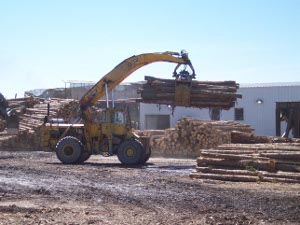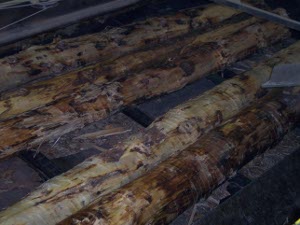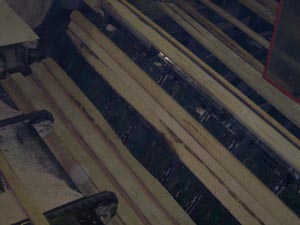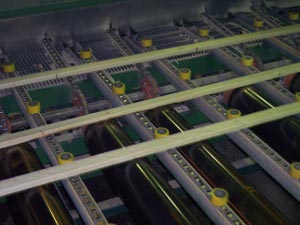 Pick up sticks
childhood memorabilia of this popular singer.
Pick up sticks
childhood memorabilia of this popular singer.
Timmins, Ontario, offers its tourists a variety of attractions which could be found no place else. Many billboards in the area advertise the Shania Twain center, an elegant new building in which pre-adolescent girls happily chatter their way through exhibits of album covers, clothing, and  Pick up sticks
childhood memorabilia of this popular singer.
Pick up sticks
childhood memorabilia of this popular singer.
Also available in Timmins are two mine tours -- a recreation of underground 1950s gold mining, and a bus tour of the enormous open pit Dome mine operations. That part of Ontario highway 101 built on mine tailings is dubbed The Golden Mile. Nearby Shumacher is named for a local entrepreneur who luckily invested in what turned out to be the richest gold claim, and practiced community philanthropy, still remembered by the endowment of annual Christmas presents for the local schoolchildren.
We opted for the free Domtar sawmill tour. Our guide was a summer hire, a young woman studying to be a teacher at the local university. She fitted us out with hard hat, orange safety vest, ear plugs, safety goggles, led us up and down the catwalks, and at the end gave us some pencils and company literature.
 After bark removal
After bark removal
We have written about our Gee Whiz excitement at the Ford truck factory at River Rouge in Dearborn, Michigan. We had similar oohs and ahhs about the sawmill technology.
You might best think of this plant as a two-by-four production plant, sort of a mechanized adjunct to the building of frame houses. Domtar, a good-sized multinational company, but only about eighth among the giant forest product companies, is based in Montreal and has perhaps a couple dozen mills in the U.S. and Canada. Most of their output is newsprint, still the biggest consumer of planted and harvested trees from the continent's giant tree farms; but in Timmins each pine or spruce is made most often into a combination of boards two inches thick, and four, six, eight or more inches in width.
One of our grandfathers ran a travelling sawmill a hundred years ago, and his eyes would have popped out of his head to see the way a month's  Replacement blades ready
work of his twenty-man logging crew could be accomplished in a day with one man and the right machinery. We didn't see this in the sawmill, but in the Domtar documentary that showed the lumbering operations as well as the millwork. A single machine cuts the tree down, grasping it in a huge metallic hand to hold it up, then in one pass down the trunk it strips off all the branches, after which the operator stacks the harvested "stick" to be trucked to the mill.
Replacement blades ready
work of his twenty-man logging crew could be accomplished in a day with one man and the right machinery. We didn't see this in the sawmill, but in the Domtar documentary that showed the lumbering operations as well as the millwork. A single machine cuts the tree down, grasping it in a huge metallic hand to hold it up, then in one pass down the trunk it strips off all the branches, after which the operator stacks the harvested "stick" to be trucked to the mill.
A day or two later we drove on a Private Logging Road Open To The Public and saw these huge trucks with two trailers barrelling down the dusty road at 85 kilometers an hour. Fortunately the road was so wide that we kept well to our side and waited for the dust to subside before proceeding at a sedate 50 kmph. We'd seen these same lumber roads in backwoods Maine and New Brunswick, so it didn't come as a surprise, but was still pretty scary.
But to return to the sawmill. Grandfather's job is now done by a computer. That is, the logs are de-barked and then each log is spun around  The computer decides how to cut
and its diameter measured at several points, to provide a computer representation; then the computer decides how to saw the log into lumber for maximum marketable yield and minimum waste.
The computer decides how to cut
and its diameter measured at several points, to provide a computer representation; then the computer decides how to saw the log into lumber for maximum marketable yield and minimum waste.
Think of the process as an efficient extension of the old square-timber industry, which took the cylindrical log and sawed off opposite sides to form a roughly squared timber which could readily be loaded in the hold of a nineteenth-century sailing ship for transport to Europe. A good deal of usable lumber was lost in this process, but the cargo was packed more tightly in the ships. These days a series of orthogonal saw cuts gradually slices boards off the logs, about as easily as a deli counter slices cold cuts off a loaf.
We saw a replacement saw blade in the loft as we walked around the mill. It's a giant band of thick sheet steel, somehow created in a  Detail of board mover
continuous piece which wraps around two enormous drive wheels which spin at incredible speed. Perhaps the length of this huge band saw blade is 25 feet, to allow for very gentle curvature around huge wheels and ample space to place the automated bed that feeds the logs into the teeth of the saw. It seemed to take about one second for each pass of a sixteen-foot log through the blade. One piece went one way, the other was rolled over and automatically fed back where it came from for another pass through the blade. But the saw did not wait for this tree to return; another tree and another slid through, all being cut according to a computer-determined rule which managed to keep the separate trees and their pattern of cuts straight. It was, frankly, bewildering to see.
Detail of board mover
continuous piece which wraps around two enormous drive wheels which spin at incredible speed. Perhaps the length of this huge band saw blade is 25 feet, to allow for very gentle curvature around huge wheels and ample space to place the automated bed that feeds the logs into the teeth of the saw. It seemed to take about one second for each pass of a sixteen-foot log through the blade. One piece went one way, the other was rolled over and automatically fed back where it came from for another pass through the blade. But the saw did not wait for this tree to return; another tree and another slid through, all being cut according to a computer-determined rule which managed to keep the separate trees and their pattern of cuts straight. It was, frankly, bewildering to see.
The sawed planks are then moved through the plant lengthwise on giant rollers, and kept parallel by guides that touch the boards a few feet apart. The ends are cut off to the appropriate length, to insure the best merchantability of the product. This kind of construction wood is graded in four categories, we were told, and the plant tries hard to keep most of its product in grades 1 or 2, as the lower grades of lumber command much lower prices.
The boards are then stacked in gigantic pallets, each layer of boards separated from the next by spacers. The pallet is strapped securely and then fed into an enormous outdoor kiln, or hot air drying oven, where in twenty-four hours the softwood moisture content is reduced from 60 to 80% down to 19%, making it dry enough to sell and use. There's still enough moisture for the unmistakeable aroma of cut pine to reach the nostrils!
The dried lumber then returns to the roller conveyor system for grading. We saw an endless line of two by fours sliding by the watchful eyes  Boards waiting for the dryer
of two graders, sitting in console seats with a bunch of control buttons at their fingertips. Underneath the conveyors were little punching arms, which swung up from below and neatly flipped each two by four over on its back, allowing the graders to examine both sides. Needless to say, these boards were flying past at a good speed, and the graders were concentrating hard with the mental effort of classifying the wood. A push of a button labelled 1 to 4 would allow the automated conveyor system to select the correct two by four and slide it out of the line for grading in one of the other categories than 2, the normal grade of this cut lumber.
Boards waiting for the dryer
of two graders, sitting in console seats with a bunch of control buttons at their fingertips. Underneath the conveyors were little punching arms, which swung up from below and neatly flipped each two by four over on its back, allowing the graders to examine both sides. Needless to say, these boards were flying past at a good speed, and the graders were concentrating hard with the mental effort of classifying the wood. A push of a button labelled 1 to 4 would allow the automated conveyor system to select the correct two by four and slide it out of the line for grading in one of the other categories than 2, the normal grade of this cut lumber.
The only part of the operation still dominated by manual labor is the end of the line, where about eight men grabbed the two by fours and stacked them on pallets, according to grade. A giant fork lift truck carried off the pallet and returned an empty one for the team to fill again.
Later the boards are slid off the pallet, one huge stack of 192 two by fours, which passes through a packaging station. Here the stack of two by fours is strapped with three steel bands, with cardboard protectors at each corner. The strapping is all done by a single automatic machine. In this wet climate, the boards must be covered with a sheet of plastic (emblazoned with the name Domtar, of course) which two men neatly staple to the sides and ends of the package.
Just as in the Ford plant, the goal is to process the logs into marketable lumber as quickly as possible and truck the strapped and wrapped  Grading the finished boards
bundles off to the customer. We didn't inquire about the sales end, but we imagine Domtar has a small sales force and a few large customers, such as building material chain stores or even large individual builders.
Grading the finished boards
bundles off to the customer. We didn't inquire about the sales end, but we imagine Domtar has a small sales force and a few large customers, such as building material chain stores or even large individual builders.
The entire saw mill consists of perhaps a dozen operations, each of which is watched on closed-circuit TV. At one end of the mill the highest-paid mill employee sits watching a bank of computer monitors and control buttons that would rival any aircraft cockpit for complexity. He can stop or start any part of the manufacturing line as needed, or send someone to a trouble spot to make repairs immediately.
We've spoken of men, but we did see a number of women working in the sawmill as well. With all the automated machinery, there is much less brute force involved, and no doubt the pay is much better than more sedentary positions. Just 150 people work in this entire mill, which produces an enormous amount of lumber.
This softwood is grown nearby in tree plantations -- on Wednesdays there are tours of the tree nursery -- which reminded us that these  Ready to ship
particular trees are a crop no different (except in the number of years required before harvest) than corn or oats. the era of stripping the continent bare of hardwood primeval forest was the nineteenth century. Further, even before there were humans logging the planet, periodic wild fires destroyed the forests much more catastrophically, and took the animal populations, too.
Ready to ship
particular trees are a crop no different (except in the number of years required before harvest) than corn or oats. the era of stripping the continent bare of hardwood primeval forest was the nineteenth century. Further, even before there were humans logging the planet, periodic wild fires destroyed the forests much more catastrophically, and took the animal populations, too.
We can't go as far in our enthusiasm as we did when raving about the Ford assembly plant, for a sawmill is still a sawmill; very noisy, inherently dangerous, dirty with sawdust and wood chips as byproducts, filling the air with particulates that are hard on the lungs. Oddly, though, we didn't see any workers wearing breathing masks. So for us it was a nice place to visit but we wouldn't want to work there!
P. S. If you decide to visit Timmins be advised that some of the tours only run one or two days during the week.